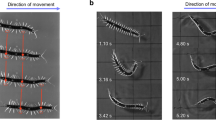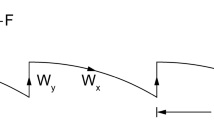Abstract
FOUR main types of locomotion have been described in limbless terrestrial vertebrates1,2. Three of these (serpentine, concertina and sidewinding) depend on lateral undulations which are essentially similar to those of aquatic vertebrates, although more complex. The fourth, rectilinear locomotion, is found in some limbless animals which need to move in conditions which prohibit lateral undulations. The skin in these animals is largely free from the underlying muscles for part or all of the body circumference, being attached only by specially developed cutaneous muscles. These move the skin in segmental units and also transmit the locomotor forces to the body, which is driven forwards continuously while the skin is regionally engaged in static friction with the substrate. The spinal column and ribs remain straight. In amphisbaenids, in which rectilinear locomotion is best developed3, the external appearance resembles that of an earthworm. The skin folds between annular regions of attachment to produce thickened regions which pass along the body.
This is a preview of subscription content, access via your institution
Access options
Subscribe to this journal
Receive 51 print issues and online access
$199.00 per year
only $3.90 per issue
Buy this article
- Purchase on Springer Link
- Instant access to full article PDF
Prices may be subject to local taxes which are calculated during checkout
Similar content being viewed by others
References
Gans, C., Amer. Zool., 2, 167 (1962).
Gray, J., Animal Locomotion (Weidenfeld and Nicolson, London, 1968).
Gans, C., Bull. Amer. Mus. Nat. Hist., 119, 135 (1960).
Taylor, E. H., The Caecilians of the World (University of Kansas Press, Lawrence, 1968).
Author information
Authors and Affiliations
Rights and permissions
About this article
Cite this article
GAYMER, R. New Method of Locomotion in Limbless Terrestrial Vertebrates. Nature 234, 150–151 (1971). https://doi.org/10.1038/234150a0
Received:
Issue Date:
DOI: https://doi.org/10.1038/234150a0
This article is cited by
-
Hydrostatic locomotion in a limbless tetrapod
Nature (1997)
-
Locomotion and Burrowing in Limbless Vertebrates
Nature (1973)
Comments
By submitting a comment you agree to abide by our Terms and Community Guidelines. If you find something abusive or that does not comply with our terms or guidelines please flag it as inappropriate.



